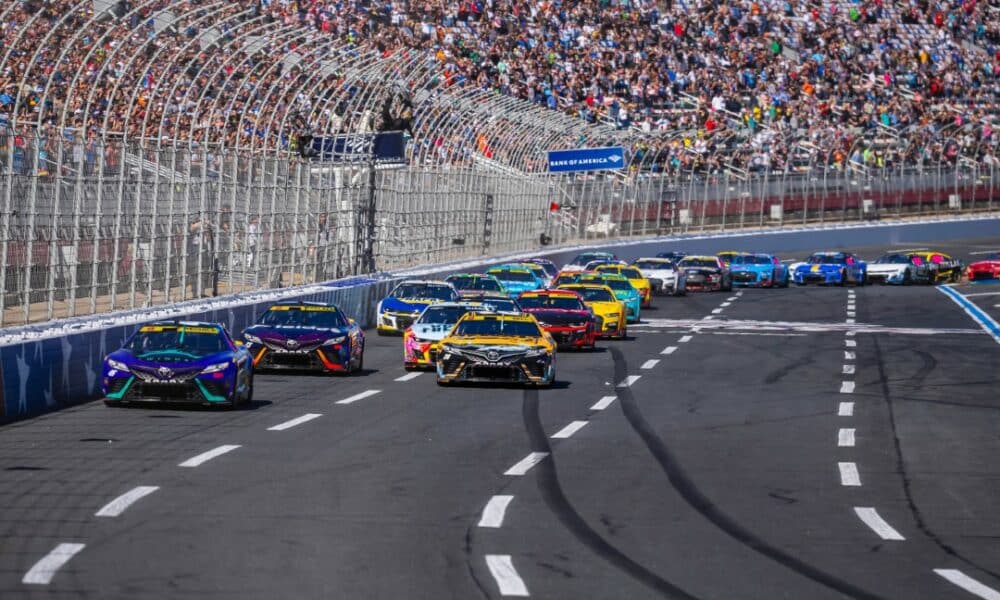In a decision that took the motorsport community by surprise, NASCAR announced that starting in 2025, cars driven by rookie drivers will no longer feature the iconic yellow stripes on their rear bumpers. This tradition, which has been a hallmark of the series for decades, was a way to distinguish rookie drivers, allowing both fellow competitors and fans to easily identify those in their first season. While the change does not affect the cars’ performance, it has sparked discussions about preserving NASCAR’s long-standing traditions and what this shift means for the future of the sport.
The announcement, confirmed by official NASCAR sources and sports journalists such as Jeff Gluck, sent shockwaves through fans and industry personalities alike. In a recent statement, former driver and commentator Dale Earnhardt Jr. expressed surprise and disappointment over the change, calling it “a blow to a great tradition that everyone loved.” According to NASCAR, the removal of the stripes is justified by the argument that, in today’s era of advanced technology and heightened competition, there is no longer a need to distinguish rookies in this way.
Historically, the yellow stripes were introduced to help veteran drivers easily identify rookies and act with more caution during races, especially on high-speed tracks like the Daytona 500. For Dale Jr., the removal of this symbol represents more than just a regulatory change; it is the loss of a significant part of NASCAR’s history and culture, which has always been marked by small but meaningful traditions. Removing the stripes, he believes, ignores the importance of the spectator’s experience, who has always used this visual cue to connect with rookies and track their progress in NASCAR.
The Historical Significance of “Rookie Stripes” in NASCAR
For years, the yellow stripes served not only as a mark of distinction but also as a symbol of growth and evolution for drivers within NASCAR. For many, they represented the journey of a rookie entering one of the most difficult and competitive racing championships in the world. In the 1980s, as Dale Earnhardt Jr. reminisced, the stripes were particularly relevant. During a time when the Daytona 500 attracted around 80 cars competing for limited spots, with a large portion being rookies, the stripes were vital in ensuring that veteran drivers could recognize who they were racing against. This simple detail helped maintain safety and race integrity, as veterans could anticipate the behavior of rookies, who often lacked experience on the track.
In high-visibility races like the Daytona 500, the yellow stripes were part of the atmosphere, and although they were simple, they played a crucial role in helping fans understand who was in their first season. Moreover, this visual detail was a way to celebrate the inclusion of rookies and reinforce the idea that NASCAR was, above all, a competition where talent and perseverance allowed drivers to be recognized and eventually succeed. By removing this symbol, NASCAR seems to question the need to represent the rookie journey in such a public manner.
Although the stripes had no bearing on car performance or technical aspects, their cultural and symbolic value in NASCAR was undeniable. For both fans and participants, they were a constant reminder of the race’s evolution and the development of the drivers, much like iconic names such as Dale Earnhardt Jr., who also began his career as a rookie and carried his own yellow stripes throughout his journey. The racing legend highlighted that, for him, the stripes had always represented an important milestone—not only for rookies but for everyone involved in the NASCAR community.
NASCAR’s Change of Perspective: What Drove the End of the Stripes?
The official explanation given by NASCAR for removing the rookie stripes is that, at the highest levels of competition, such as the Cup Series, the stripes are no longer necessary. NASCAR believes that, with the evolution of the series and the increasing visibility of rookies on digital platforms, fans can easily identify who the first-year drivers are. Additionally, marketing and communication teams within racing organizations already ensure that rookies receive ample exposure through interviews, social media, and other forms of publicity, eliminating the need for the traditional visual identifier.
Another point raised by NASCAR regarding the change was the aim to simplify the visual aesthetic of the races. The idea is to create a more uniform field, where the cars of all drivers, regardless of experience, have a more consistent appearance. This includes removing any detail that could be seen as overly identifying. The shift can be viewed as an attempt to modernize the competition’s look, aligning with the idea that NASCAR needs to reinvent itself to attract new generations of fans, while also enhancing the experience for older spectators.
However, as with many decisions in NASCAR’s history, this change has sparked controversy. While NASCAR’s priority is to adapt the series for new generations and heightened competition, critics argue that certain traditions, like the rookie stripes, represent an essential link to the past and help preserve the essence of the competition. For many, the stripes were more than a technical or aesthetic detail; they were part of the soul of NASCAR, symbolizing the battle of young drivers for the opportunity to stand out among the racing greats.
Reactions from Drivers and Fans
The reactions to the change were not favorable among many in the community. Dale Earnhardt Jr., in particular, expressed his surprise upon discovering the news just as the public did, through a post on social media by Ryan Williams, a designer for JRM Racing. The former driver mentioned on the podcast Dale Jr. Download that he was taken aback by the decision, emphasizing that the stripes had always represented a great tradition that existed naturally within motorsport. He questioned the need for the change, as the stripes had no effect on the race’s outcome, and stated that, no matter how simple, they had an emotional significance for everyone involved.
Fans, too, did not hide their displeasure with the move. On social media, many expressed frustration over the loss of such an important NASCAR symbol. For long-time supporters, the stripes were a distinctive feature that made each season special. Without them, many feel as though NASCAR is abandoning its roots and moving further away from what made the competition unique.
Moreover, the removal of the stripes also impacts the marketing and publicity teams, who used the stripes as a way to highlight their rookies and generate more fan engagement. For sponsors, who often associate their brands with these rookie drivers, the visual symbol of the stripes was an important tool for increasing visibility and drawing new fans to the sport.
The Future of Rookies in NASCAR: No Stripes, But New Challenges Ahead
Despite the controversy surrounding the removal of the rookie stripes, the 2025 season is expected to bring new challenges and opportunities for the series’ rookies. Drivers like Riley Herbst, Shane van Gisbergen, and Carson Hocevar will be the new faces of NASCAR, and the competition among them promises to be one of the biggest highlights of the season. Although the stripes will no longer be present to identify them, fans will still have the chance to follow the development of these rising stars.
With the increasing number of experienced competitors and the sophistication of monitoring and analysis technologies, rookie performance will become even more about pure skill and adaptability to NASCAR’s racing system. While rookies may no longer have the visibility provided by the stripes, they will find other ways to stand out—whether through on-track performance, innovative racing strategies, or their charisma in engaging with fans.
The removal of the stripes could also pave the way for a new era in NASCAR, where rivalries between veterans and rookies could become even more intense. Without the visual cue of distinction, rookies will need to prove their worth through tangible results, overcoming challenges and making their mark with exceptional performances on the track.

In a decision that took the motorsport community by surprise, NASCAR announced that starting in 2025, cars driven by rookie drivers will no longer feature the iconic yellow stripes on their rear bumpers. This tradition, which has been a hallmark of the series for decades, was a way to distinguish rookie drivers, allowing both fellow competitors and fans to easily identify those in their first season. While the change does not affect the cars’ performance, it has sparked discussions about preserving NASCAR’s long-standing traditions and what this shift means for the future of the sport.
The announcement, confirmed by official NASCAR sources and sports journalists such as Jeff Gluck, sent shockwaves through fans and industry personalities alike. In a recent statement, former driver and commentator Dale Earnhardt Jr. expressed surprise and disappointment over the change, calling it “a blow to a great tradition that everyone loved.” According to NASCAR, the removal of the stripes is justified by the argument that, in today’s era of advanced technology and heightened competition, there is no longer a need to distinguish rookies in this way.
Historically, the yellow stripes were introduced to help veteran drivers easily identify rookies and act with more caution during races, especially on high-speed tracks like the Daytona 500. For Dale Jr., the removal of this symbol represents more than just a regulatory change; it is the loss of a significant part of NASCAR’s history and culture, which has always been marked by small but meaningful traditions. Removing the stripes, he believes, ignores the importance of the spectator’s experience, who has always used this visual cue to connect with rookies and track their progress in NASCAR.
The Historical Significance of “Rookie Stripes” in NASCAR
For years, the yellow stripes served not only as a mark of distinction but also as a symbol of growth and evolution for drivers within NASCAR. For many, they represented the journey of a rookie entering one of the most difficult and competitive racing championships in the world. In the 1980s, as Dale Earnhardt Jr. reminisced, the stripes were particularly relevant. During a time when the Daytona 500 attracted around 80 cars competing for limited spots, with a large portion being rookies, the stripes were vital in ensuring that veteran drivers could recognize who they were racing against. This simple detail helped maintain safety and race integrity, as veterans could anticipate the behavior of rookies, who often lacked experience on the track.
In high-visibility races like the Daytona 500, the yellow stripes were part of the atmosphere, and although they were simple, they played a crucial role in helping fans understand who was in their first season. Moreover, this visual detail was a way to celebrate the inclusion of rookies and reinforce the idea that NASCAR was, above all, a competition where talent and perseverance allowed drivers to be recognized and eventually succeed. By removing this symbol, NASCAR seems to question the need to represent the rookie journey in such a public manner.
Although the stripes had no bearing on car performance or technical aspects, their cultural and symbolic value in NASCAR was undeniable. For both fans and participants, they were a constant reminder of the race’s evolution and the development of the drivers, much like iconic names such as Dale Earnhardt Jr., who also began his career as a rookie and carried his own yellow stripes throughout his journey. The racing legend highlighted that, for him, the stripes had always represented an important milestone—not only for rookies but for everyone involved in the NASCAR community.
NASCAR’s Change of Perspective: What Drove the End of the Stripes?
The official explanation given by NASCAR for removing the rookie stripes is that, at the highest levels of competition, such as the Cup Series, the stripes are no longer necessary. NASCAR believes that, with the evolution of the series and the increasing visibility of rookies on digital platforms, fans can easily identify who the first-year drivers are. Additionally, marketing and communication teams within racing organizations already ensure that rookies receive ample exposure through interviews, social media, and other forms of publicity, eliminating the need for the traditional visual identifier.
Another point raised by NASCAR regarding the change was the aim to simplify the visual aesthetic of the races. The idea is to create a more uniform field, where the cars of all drivers, regardless of experience, have a more consistent appearance. This includes removing any detail that could be seen as overly identifying. The shift can be viewed as an attempt to modernize the competition’s look, aligning with the idea that NASCAR needs to reinvent itself to attract new generations of fans, while also enhancing the experience for older spectators.
However, as with many decisions in NASCAR’s history, this change has sparked controversy. While NASCAR’s priority is to adapt the series for new generations and heightened competition, critics argue that certain traditions, like the rookie stripes, represent an essential link to the past and help preserve the essence of the competition. For many, the stripes were more than a technical or aesthetic detail; they were part of the soul of NASCAR, symbolizing the battle of young drivers for the opportunity to stand out among the racing greats.
Reactions from Drivers and Fans
The reactions to the change were not favorable among many in the community. Dale Earnhardt Jr., in particular, expressed his surprise upon discovering the news just as the public did, through a post on social media by Ryan Williams, a designer for JRM Racing. The former driver mentioned on the podcast Dale Jr. Download that he was taken aback by the decision, emphasizing that the stripes had always represented a great tradition that existed naturally within motorsport. He questioned the need for the change, as the stripes had no effect on the race’s outcome, and stated that, no matter how simple, they had an emotional significance for everyone involved.
Fans, too, did not hide their displeasure with the move. On social media, many expressed frustration over the loss of such an important NASCAR symbol. For long-time supporters, the stripes were a distinctive feature that made each season special. Without them, many feel as though NASCAR is abandoning its roots and moving further away from what made the competition unique.
Moreover, the removal of the stripes also impacts the marketing and publicity teams, who used the stripes as a way to highlight their rookies and generate more fan engagement. For sponsors, who often associate their brands with these rookie drivers, the visual symbol of the stripes was an important tool for increasing visibility and drawing new fans to the sport.
The Future of Rookies in NASCAR: No Stripes, But New Challenges Ahead
Despite the controversy surrounding the removal of the rookie stripes, the 2025 season is expected to bring new challenges and opportunities for the series’ rookies. Drivers like Riley Herbst, Shane van Gisbergen, and Carson Hocevar will be the new faces of NASCAR, and the competition among them promises to be one of the biggest highlights of the season. Although the stripes will no longer be present to identify them, fans will still have the chance to follow the development of these rising stars.
With the increasing number of experienced competitors and the sophistication of monitoring and analysis technologies, rookie performance will become even more about pure skill and adaptability to NASCAR’s racing system. While rookies may no longer have the visibility provided by the stripes, they will find other ways to stand out—whether through on-track performance, innovative racing strategies, or their charisma in engaging with fans.
The removal of the stripes could also pave the way for a new era in NASCAR, where rivalries between veterans and rookies could become even more intense. Without the visual cue of distinction, rookies will need to prove their worth through tangible results, overcoming challenges and making their mark with exceptional performances on the track.







